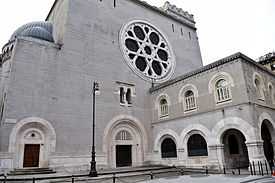Synagogue of Trieste
| Synagogue of Trieste | |
|---|---|
|
External view | |
| Basic information | |
| Location |
|
| Affiliation | Orthodox Judaism |
| Status | Active |
| Leadership | Rabbi David Yitzak Margalit |
| Architectural description | |
| Architect(s) |
Ruggero Berlam Arduino Berlam |
| Completed | 1912 |
The Synagogue of Trieste (Italian: Tempio Israelitico di Trieste) is a Jewish house of worship located in Trieste, northern Italy.
History
It was built between 1908 and 1912, and bears the hallmark of architects Ruggero and Arduino Berlam. The Shul was unveiled in 1912 in the presence of city authorities, and it replaced the four smaller Synagogues that previously existed.
The synagogue was closed in 1942 following the instigation of the Race laws under the Fascist regime. As soon as the war finished the synagogue went back into operation. Today it is recognised as one of the largest and most important places of worship for Jews in Europe.
Architectural style
Different architectural styles have successfully blended into this building, whose essence is represented by four powerful marble pillars supporting an imposing central dome.
The style has been described as follows:
The exterior style was said to be late Roman of a type found in fourth-century Syria, and the architects chose it because it brought them close as possible to ancient Jewish architecture. Jews in the Holy Land and throughout the Roman Empire had used Roman forms. Syria was near enough to the Holy Land to incorporate design elements used by Jews. A synagogue in this style could suggest the wide geographic distribution of Jews, both in the Roman Empire and in modern times. It could suggest the proximity of Jews to others within the ancient and the modern Roman (that is, Habsburg) empires. It could suggest the Jews' Middle Eastern origin without making them look too close to Byzantine Christians or to Moslems."
References
- Jewish Community of Trieste Official website
- Synagogues of Europe, P. 372, Carole Herselle Krinsky
Coordinates: 45°39′11.43″N 13°46′49.21″E / 45.6531750°N 13.7803361°E
